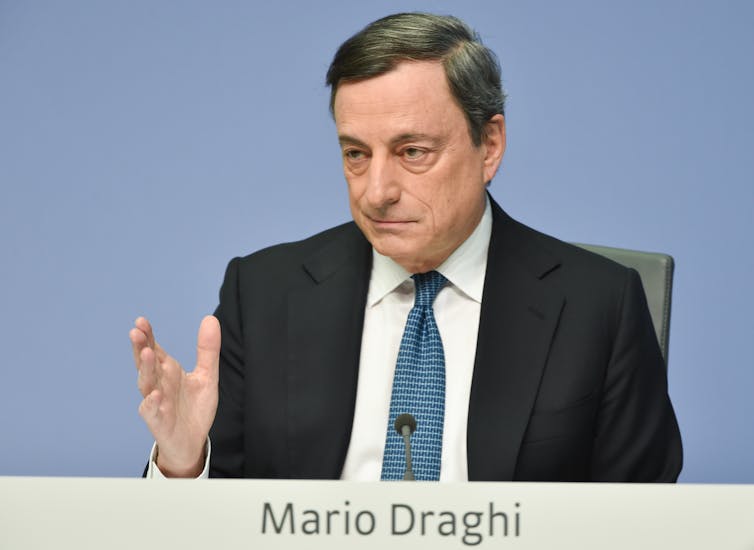The European Central Bank has introduced a slate of new measures to try and bolster growth in the eurozone. Some have referred to Mario Draghi, the ECB president, as bringing out his “bazooka”. Faced with the threat of deflation, he is keen to try and boost inflation nearer to its target level of around 2% from its current level of -0.2%.
The real economy in the eurozone is not doing very well. Real GDP grew at around 0.3% toward the end of last year, weaker than expected by many economists and the outlook for 2016 is moderate at best. The ECB hopes its policies will increase demand through financing conditions, increases in employment and structural reform.
Here are the three measures that are geared towards increasing the availability of credit, spurring a faster economic recovery and generating a more acceptable level of inflation.
1. Interest rates cut
The ECB’s three main interest rates have been cut. The refinancing rate – the interest banks are charged for borrowing from the ECB – has been cut by five basis points from 0.05% to zero. The rate on its marginal lending facility, by which it makes overnight credit available to banks, has also been cut by five basis points to 0.25%. And the deposit facility – the rate paid to banks for overnight deposits – by ten basis points to -0.40%.
All of this is aimed at increasing the liquidity of commercial banks in the eurozone and encouraging lending. By charging banks more to keep deposits at the central bank and less to borrow from it, the hope is that they have less incentive to hold onto their cash.
The refinancing rate meanwhile, is likely to remain at the present level or lower for the foreseeable future, because of low inflation and the sluggish recovery.
Banks, who are of course at the heart of this lending and credit provision strategy, welcomed the move and have enjoyed an increase in share prices during trading since the announcements. They are more confident about avoiding funding problems, because the cost of insuring against collapse is lower now that credit easing is being ramped up.
2. More quantitative easing
Draghi also announced another round of quantitative easing – the introduction of new money into the economy. It is the eleventh attempt to reignite money supply growth since he took the helm and will increase the current injection of €60 billion a month to €80 billion each month.

To facilitate this, the ECB will electronically increase the amount of credit in its own bank account and use it to buy assets such as bonds or equities from other banks, a process called asset purchases. This will continue for at least another year or until the inflation rate returns to its target of less than, but close to 2%. Plus, the ECB is increasing the percentage of the share purchases that it is able to buy, up from a third to a half.
Quantitative easing will also be widened to include euro area corporate bonds, which are credit-rated bonds issued by companies. These are usually bought and sold on secondary markets, offering high yields when ratings are low and low yields when ratings are high. This should lead to more money filtering through to what we call the real economy – where goods and services are actually produced, rather than financial markets where shares are traded.
3. Financing for banks
A series of targeted longer-term refinancing operations were also announced, to begin later this year. Commercial banks will effectively be paid to borrow central bank funds. They are being offered funds to lend to consumers and businesses for spending in the real economy (the money cannot be used for mortgages, for example). Banks that participate would pay back less at the end of the four-year loan than they borrowed. Liquidity is also offered to banks which need to continue lending between themselves and to avoid another credit crunch.
So this monetary stimulus, as the ECB is calling it, is an effort to help the eurozone economy grow faster by increasing the amount of money supplied to it. Doubts persist, however, about whether or not the policies explained here will prove successful.
Much of the ECB’s stimulus depends on there being sufficient demand for loans, which has long been questionable. If there isn’t sufficient loan demand, simply making loans cheaper is unlikely to have a significant impact. There has also been speculation in recent months about the health of the banking sector, though not quite another banking crisis just yet. These measures will help dampen those fears. But the fact that the ECB has had to intercede again, points to how serious such concerns are.

